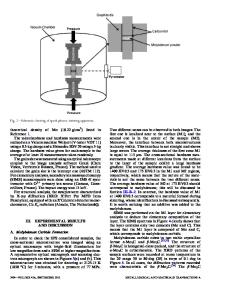Perspectives on the spark plasma sintering process
- PDF / 2,888,876 Bytes
- 15 Pages / 595.276 x 790.866 pts Page_size
- 69 Downloads / 480 Views
Perspectives on the spark plasma sintering process Zuhair A. Munir1,* 1 2
and Manshi Ohyanagi2
Department of Materials Science and Engineering, University of California, Davis, CA 95616, USA Department of Materials Chemistry, Ryukoku University, Ohtsu 520-2134, Japan
Received: 19 July 2020
ABSTRACT
Accepted: 29 August 2020
This Viewpoint paper is written in conjunction with the Journal’s celebration of 1000 at 1000, a milestone of reaching the publication of the 1000th issue and highlighting those papers that have been cited 1000 or more times. One of the authors’ papers is in this category, as indicated in a previous Editorial by one of us. In this Viewpoint, we discuss the phenomenal success of the spark plasma sintering process, providing a historical account, presenting an updated overview of the accomplishments attributed to the process, and highlighting selected examples of these.
Ó
Springer Science+Business
Media, LLC, part of Springer Nature 2020
Introduction Periodically, the emergence of a particular scientific topic or a process captures the attention of a large number of investigators worldwide resulting in an extraordinary increase of studies and publications dealing with various aspects of the topic or the process. A recent example of this is the spark plasma sintering (SPS) process. Evidence for the remarkable increase in interest in this topic can be gleaned from the trend in the papers published on this subject. In 1993, only a handful of papers were published. But by 2003, that number had increased to about 150 [1], then to nearly 1000 in 2017 [2], and to over 1400 in 2019. And this seemingly exponential trend is likely to continue for the immediate future. Concomitant with the large number of publications is a large number of published review
Handling Editor: M. Grant Norton.
Address correspondence to E-mail: [email protected]
https://doi.org/10.1007/s10853-020-05186-1
articles on the SPS process, as can be seen by the referenced representative, chronologically listed reviews [1, 3–11]. And still another indication of the increased interest in this topic is the number of citations the review articles have received. At least in one case [1], the total citation number exceeded 2000 up to the year 2020 [12]. The large interest in the SPS process is a consequence of reported observations on its remarkable accomplishments [8], including: (a) Enhanced Sintering: with this process materials have been reported to sinter at lower temperatures, to higher densities, and with shorter dwell times, (b) Improved or Unique Properties: materials sintered by the SPS have been reported to possess better, or in some cases, unanticipated advantageous properties, and (c) New Structures or Phases: using the SPS process new microstructures or phases have been prepared. More
J Mater Sci
detailed discussions of aspects of these will be provided subsequently in this paper. With all these reported special attractive accomplishments of the SPS process, the focus becomes on the specific features of the proc
Data Loading...











